| [naar
inhoudsoverzicht Strauss-dynastie]
[naar
literatuurlijst]
inhoud:
|
JOSEPH & EDUARD STRAUß
Josef Strauß (1827-1870)
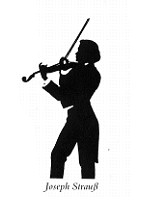
The career
Josef Strauss began his technical studies in 1842 at the Viennese polytechnic.
From 1846 on, he worked as construction draftsman in addition to his studies.
After becoming a diploma'd engineer, he worked in different branches: among
other things he constructed a road sweeper.
During the revolution of 1848, he was in the Academic Legion for a
short time, but left the
insurgents soon, hid the uniform and the weapon and retired into the
monastery of the hospitallers, where his family lived during the fights.
During his technical studies, he concerned himself also with music,
but he refused to become a professional musician. But after the strenuous
winter season, when his brother Johann contracted a serious disease and
the physicians ordered him a rest of six months, the inexperienced Josef
had to take over the direction of the Strauss band - just for a short time,
as they said. The temporary collaboration became a commitment for life.
Three years later, he was compelled to give up his technical career in
favor of the music and the family "show business".
He performed for the first time with the Strauss band on July 23rd 1853
at "Sperl" and was very successful. As Josef was neither experienced in
conducting nor a versed violinist able to conduct the orchestra with the
instrument in his hands, he took violin lessons again and continued also
his studies of musical theory. Although he had not the strong personal
magnetism of his brother, he became also as conductor soon popular with
the public.

"Zum Sperl" - garden
But when they both performed at the same event, Josef was in the famous
brother's shadow. Therefore, he tried to distinguish himself as composer
as well as conductor. Already in his first "musical summer" in 1853, he
threw the usual programming of the Strauss concerts, composed of dances
and popular opera themes, overboard in conducting also Liszt's symphonic
poem "Mazeppa" and scenes from Wagner's "Lohengrin". Later, he incorporated
other works of the new German school and different compositions of the
classicism and the Romanticism in therepertoire.
His duties as conductor grew in the course of time. In 1856, he gave
up his career as engineer for good, when he had to act for Johann for six
months during his sojourn in Russia. In 1862, the elder brother sent him
even to Russia to the summer concerts in Pavlovsk, since he went back to
Vienna "for medical reasons" (but in actual fact because of his marriage).
In 1863, Johann became Hofballmusikdirektor and his performances were restricted:
Josef and Eduard assumed the other duties as conductors. But the collaboration
of the two brothers free from conflicts. Josef was responsible for most
of the events.
The great professional stress contributed probably to the aggravation
of his uncleared congenital disease. Syncopal attacks and collapses became
more frequent without the physicians being able to detect the cause. Nevertheless,
new plans were made again and again. For summer 1870, they scheduled a
great concert tour to Warsaw - it became his last journey.
On the occasion of the inaugural ceremonies of the new Musikverein building
in January 1870, all three brothers played and each one contributed a new
composition. In March, they performed again at the Musikverein and
this was their last joint performance.

Grave Josef Strauß
at the Wiener Zentralfriedhof
In April 1870, Josef set out for Warsaw, where several concerts were
timed at the establishment "Schweizertal". But the journey started with
a fiasco: The books of music and the instruments arrived too late and the
band was incomplete. Finally, they started with the concerts two weeks
behind the schedule. The agitation told heavily on Josef: During a concert,
he had once more a heavy syncope with paralytic symptoms and speech disorders.
The patient was transported to Vienna where he died on July 22nd. Three
days later, he was buried close to his mother at the St. Marxer Friedhof
in deep sympathy of the people and later he was laid to rest at the Zentralfriedhof
(Ehrengräber-Gruppe 32 A, No. 44).
The works
Within 17 years of musical work, Josef Strauss left to us 283 printed works:
mainly dances
(waltzes, polkas, polka-mazurkas, quadrilles, marches and ländler),
but also lieder and two
plays, an operetta after his own libretto and a tragedy.
As composer, he wanted to take his own way: His symphonic concert waltzes
were orientated by Liszt's and Wagner's tone style and had not much in
common with the popular light music of the Strauss family. But these works
kept unpublished and are missing as well as the other autographs of the
composer.
Some dances (for instance the "Pizzikato-Polka") were composed in "teamwork"
with Johann and Eduard.
The adaptations for the Strauss band are of particular importance in
the works of Josef Strauss. Josef was the most talented composer among
the three brothers at all. Johann saw the talent of his brother and he
is supposed to have said several times: "Pepi is more talented, I am more
popular."
Josef's tone style has poetic, romantic melancholic characteristics
and is influenced by Schubert and Chopin. The freely composed waltz introductions
as well as some polka-mazurkas show stylistic characteristics of the new
German school.
Private things
On June 8th 1857, Josef Strauss married Caroline Pruckmayer (1831-1900)
at the church St.Johann in Leopoldstadt. The couple lived with the extended
family at the Hirschenhaus in Leopoldstadt. In 1858, the only child was
born, Karolina Anna (deceased 1919).
After Josef's death, Caroline moved to Karmelitergasse 9. In 1893 she
moved to Czermakgasse 16 in Währing. She died on November 22nd 1900
in Hainfeld.
Josef's musical estate came first to Johann and Eduard took it over
a few years later. Today, we have to puzzle about the destiny of the manuscripts,
because not an autograph, not even sketches are transmitted by Josef Strauss,
just his printed works.
Eduard Strauß (1835-1916)
The career
Eduard Strauss graduated from the Viennese academic gymnasium and aspired
to a diplomaticcareer, but his mother opposed this plan. He allowed himself
to be persuaded to study music, took theory, piano and violin lessons and
learned the fashionable instrument harp.
In carnival 1861, he made his debut as conductor: In a "Monstre-Ball"
at the Sofien-Säle (Wien 3., Marxergasse 7) each brother was conducting
a band.
Eduard contributed also a composition announced to be on the safe side
in Josef's name. In the next year, he conducted the Strauss orchestra for
the first time in an own concert at the Diana-Bad.
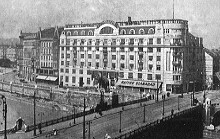
The formerly Diana-Bad
In spite of the popularity of his brothers, Eduard succeeded in winning
the public's favor. Early in 1865, when Johann and Josef contracted a serious
disease, Eduard filled the majority of the carnival performances. He had
even to act for Johann in the summer concerts in Pavlovsk in Russia. He
was successful there as conductor, but he got involved in differences,
which ended in the fact that no more Strauss was invited to Pavlovsk.
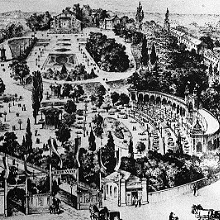
The "Neue Welt"
After Josef Strauss death in June 1870, Eduard was the only conductor
of the band. He performed with the orchestra on Thursday and Sunday at
the "Neue Welt", on Tuesday and Friday at the garden of Weghubers Caféhaus
in the Innere Stadt (Wien 1., Museumstraße), on Wednesday at the
Hotel Victoria, on Saturday at the garden of the Blumensäle and later
also at the Volksgarten.
Through many years he made the ball music in the carnival for four establishments:
On Saturdays in the carnival he played first at Dommayer, then at Schwenders
Colosseum, at the Blumensäle and finally at the Sofien-Säle.
For this ten-hour mammoth action, that he conducted himself only in part
though, he extended his band up to 120 to 130 musicians.
His "Concerts populaires" at the great hall of the Musikverein were
a novelty. Half the program of this Sunday's event, where the audience
sat at tables and drinks were served, was composed of old and new works
of the so-called "classical" music, the other half of music of the Straussfamily.
Strauss toured through Germany (1885, 1889, 1896), England (1885, 1895
and 1897), St.Petersburg (1894) and America and Canada (1890 and 1901).
On the second tour in America, Strauss went to 81 cities and gave 106
concerts. This last forced tour led to discords between him and the musicians,
so that he dissolved the band
after the home-coming in February 1901 - after about 75 years of contract
with the Strauss family.
The works
Eduard Strauss left 280 published works, more than the third part are polkas
and gallopades. His compositions are skilled solid, but they lack the personal
note. In the invention they are hardly more than a colorless reflection
of the music of his brother Johann.
Family background and dwellings
In January 1863, Eduard Strauss married Maria Klenckhart, the daughter
of an owner of a café in Leopoldstadt living vis-à-vis the
"Sperl". The couple lived first at the Hirschenhaus with the extended family,
where the two sons Johann (1866-1939) and Josef (1868-1940) were born.
In 1886, Eduard was the last Strauss to leave the Hirschenhaus with his
family and moved into a new house in the Innere Stadt (Wien 1., Reichsratstraße
9), where he lived till death.
The elder son studied law a few semesters and worked then as reviser
in the Imperial and Royal ministry of Culture and Education. About 1900,
he gave up this post in favor of the profession of musician. A year later,
he succeeded his father in the direction of the court ball music, which
he occupied until 1905. In 1906, he applied for the title of Hofballmusikdirektor
(court ball music director), but it was not conferred on him, since he
was heavily indebted. In 1907, he moved toBerlin with his family.
The financial calamities of the son had led to discords between Eduard
Strauss and his wife: through years, she had helped the son at the expense
of the family fortune and the encumberedcommon house was finally put up
for compulsory auction.
The "last Strauss"
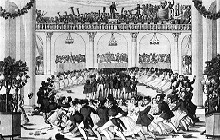
Not only an important chapter of Austrian history of music ends with
Eduard Strauss, but his death means also the end of a well-organized and
successful family business, a
"show empire", which was keen on influence and profit. The competition
of the rivals among one another contributed a lot to its boom, but brought
naturally discords into the family relations.
Eduard's relationship with his eldest brother was often strained. Johann
remembered him neither in his will he made before his journey to America
in 1872, nor in his last will.
On the occasion of the world's fair in 1873, Johann ousted him rigorously
and he was not
allowed to perform at the exhibition garden. Eduard, in his turn, was
not present at Johann's funeral, in his "memoirs" he explained incorrectly
that he was traveling. This in 1906 written autobiography contains no details
about the relations to his brothers, but because of its often distant and
critical manner there is reason to suppose that he felt less favored in
comparison with them. Probably there were such feelings at work, when Eduard
burned up the note archives of the Strauss band in 1907, according to an
arrangement with Josef of the year 1869. The material is said to have been
so extensive that the occurrence lasted hours - the most valuable documents
were irretrievably destroyed thereon.
The last years of his life, Eduard Strauss lived in seclusion in his
apartment at the Reichsratstraße. On December 28th 1916, he died
of old age. At his own request, he was laid to rest in the uniform of the
Hofballmusikdirektor at the Zentralfriedhof. His tomb is in the Ehrengräber-Gruppe
32 A, No. 42.
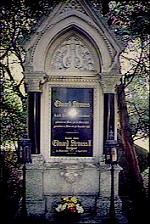
Monument Eduard Strauß
at the Wiener Zentralfriedhof
Without the work of Eduard Strauss, the Viennese dance music would have
been forgotten already a long time before the turn of the century.
In a time, when Carl Millöcker, Johann Strauss and Carl Michael
Ziehrer devoted themselves to the operetta, when the military march dominated
in the dance music, the cabaret and working class songs appeared, the last
representative of the second Strauss generation succeeded in keeping
the Viennese waltz alive for some time.
|